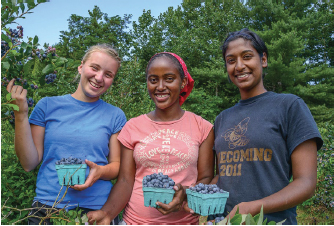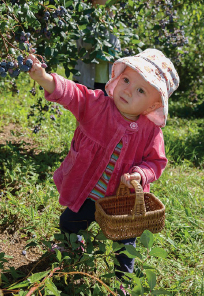Fresh fruit is best when it is fresh, period.
At a tag sale last fall, I fished a quarter out of my jacket pocket and bought a vintage cookbook titled Cooking with Berries.* I bought it because on a page that was dog-eared long ago by some other cook I saw a recipe for strawberry fritters. It said to take large, perfectly ripe, fresh strawberries, dip the whole berry in a light batter, and deep-fry each one until crisp and golden brown. Place the fried berry on a paper towel for a few seconds, then serve while still warm, generously dusted with powdered sugar. I have been looking at that recipe all winter, and, at last, it’s strawberry picking season in Vermont.
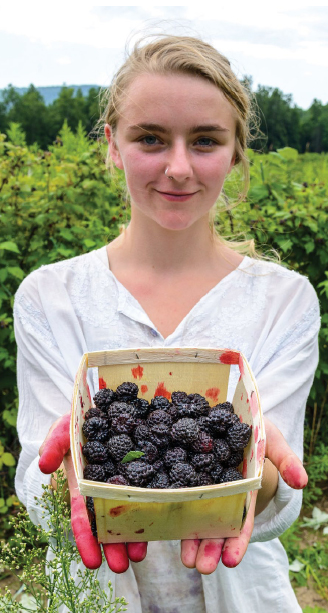
“Pick Your Own” is one of those roadside signs that tempts me to turn down lanes into lush fields and fragrant orchards throughout Vermont—those Green Mountain gardens of Eden. And I am ready. Before the first of July, the back of my car is typically strewn with the following: one or two fruit-stained t-shirts, an old pair of garden clogs, thin gardening gloves, several small cardboard boxes and a couple of empty coffee cans. Presto-chango, and I am off to the berry patches no matter where my travels take me.
I could hardly wait to fry up my first batch of strawberry fritters, so I was eager to be the first one out in the nearest field that offers Pick Your Own—for me that just happens to be Dutton Berry Farm on Route 30 in Newfane. There are some 20 fertile acres along the banks of the West River. Paul Dutton, who owns the land and runs three farmstands with his wife Wendy, tells me there is a best method, as well as a best time, to pick my own strawberries.
“The thing is, the hotter it gets, the better the fruit ripens and sweetens, but on hot days, people are not as likely to come out to the fields to pick,” he says. “Some seasons, people show up in early June, but it’s still too cool, and then they complain, ‘Where are all the big berries? What the heck is going on?’ They want to pick the half-green berries anyway, and that’s all wrong, because they are cheating themselves out of the best flavor. How is a berry supposed to make sugars unless it’s on the plant and out in the warm sunshine? That unripe berry won’t improve sitting on their kitchen counters.”
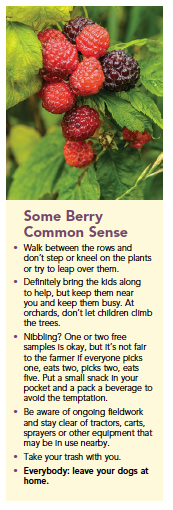 He’s right. Those last 24-hours on the plant, especially for a berry, are the magical moments when it reaches its prime. So, I learn to pick berries that I am going to use today, and perhaps tomorrow, but nothing greenish and rock-hard because now I know: fresh fruit is best when it is fresh, period.
He’s right. Those last 24-hours on the plant, especially for a berry, are the magical moments when it reaches its prime. So, I learn to pick berries that I am going to use today, and perhaps tomorrow, but nothing greenish and rock-hard because now I know: fresh fruit is best when it is fresh, period.
“Berry picking seasons are some of my favorites,” says Tracey Medeiros, a Vermont resident and author of The Vermont Farm Table Cookbook and Dishing Up Vermont. She is a huge fan of PYO. “But, I come prepared,” she says, “with my own containers recycled from last season, garden gloves, sun block, and an empty picnic cooler so that the fruit doesn’t wilt on the way home.” Wherever Medeiros is picking, she always makes a plan well in advance for what she is going to do with the fresh berries. “Before I leave the house,” she says, “I make more space in the fridge or freezer, and I clear my schedule so I know I have enough time to process the berries. In an hour on a good day, I can pick enough, with help from my family, for eating, cooking and preserving.” My new plan is to follow her plan, and pick a lot more than I have ever picked before. Maybe not bushels, but at least triple the usual amount. Perishable is the word I need to remember though. I’m not a canner, but freezing fruit is fast and easy.
“ I like that the fruit I pick is grown by people who love food as much as I do, and that they respect the earth, too.” –Tracy Medeiros, food author
“I like that the fruit I pick is grown by people who love food as much as I do, and that they respect the earth, too,” Medeiros says. “I often ask the growers how they care for their land and they are always happy to share that information. Of course, there’s no label on the strawberries in the field, so it’s okay to ask what varieties are growing there, what the characteristics of that particular hybrid are, and what kinds of recipes that berry is ideal for. Actually, growers love to talk about their farms, crops and how they manage their fields.”
I took Tracey’s advice about asking questions, and spent an hour with Paul Dutton talking about what fruits he grows and how he grows them. He also gives me the week-by-week schedule for when to be there to get the best harvests.
“Some of the strawberries are exclusively June-bearing, but other varieties are what we call ‘day-neutral’,” he says. I have no clue what day-neutral means, but Dutton has the patience to explain it detail. “You see, it’s all about the buds. The plants that bear fruit in June, only once, those have set their buds last fall and flower in early summer,” he says. “But the plants that we used to call ever-bearing–now known as ‘day-neutral’–they set buds and flower continuously, so those varieties can produce fruit for as long as the temperatures are moderate.” He explains that with a little help from some plastic row covers on autumn’s cooler days and nights, he’ll have fresh, locally grown strawberries available at the farm stands right up until Vermont’s hard frosts. In other words, strawberry season lasts much longer than it used to, and while I am picking blueberries, raspberries and blackberries in the fields at summer’s end, I can also dash over to Dutton’s store for a few pints of fresh strawberries. It sounds too good to be true, but it is true, thanks to the new hybrids, better cold-tolerant varieties and improved farming practices.
“ If you pick fruit earlier in the day when it’s still cool, it will last a little longer.” – Vern Grubinger, UVM Extension Vegetable and Berry Specialist
“With the strawberries, the ones we plant in sandier soil are the berries that come in first. We can see the large ‘Wendy’ hybrids in June and we open the pick your own fields around the 15th,” he says. He also lists the “Honeoye” and “Daroyal” among the earlier varieties, and says those are tart and good for making jam. “Jewel” are large mid-season strawberries, good for eating. “Sparkle” comes in a little later, maturing into July, and is considered an heirloom quality fruit. It is medium sized, which is the size that I prefer. Some of the later varieties are “Valley Sunset” –a tasty, large berry; and another that ripens in late July is the “Malwina”–a glossy, dark variety.
He runs through the list of PYO blueberries in the fields as well–from early to late: “Patriot” (mid-July); “Blueray” (late-July); and two late season varieties throughout August that are excellent for eating or freezing, the light-blue “Elliot”, and a large, firm blueberry called “Nelson”.
If the plants don’t produce a good yield,” he says, “I rip them out and try something else. We rotate several acres of berries with different varieties every year.” He figures he’s got about 2.5 linear miles of berries per acre that need to be picked, so Dutton offers discounts if you intend to harvest in bulk.
Proper Picking Pointers
Now, some pertinent points about proper picking. Don’t wander from plant to plant and row to row, leaving an area half-picked. Gather all the fruit that’s ripened in the place you’ve chosen, and only then move on to a new spot. Growers need to keep track of where you left off and where the next customers can begin, and it’s a lot easier when they know that certain areas have been well picked. And it’s true: any kind of berries that you pick only half-ripe will not develop more flavor–they just soften. Those are best left on the plant one more day for tomorrow’s pickers. If the picking’s good, don’t stop. Fill some extra boxes to give to a friend, to share with a neighbor or to donate to your local food shelf. On the topic of sharing, I asked Dutton how he deals with birds that might raid the berry patches early in the summer before their normal diet of wild fruits and seeds becomes plentiful. He says, “We plant enough for the birds, too. I eat about a pint a day myself.”
Professor Vern Grubinger is the vegetable and berry specialist with University of Vermont Extension, and he guided me further on my picking methods. “If you pick fruit earlier in the day when it’s still cool, it will last a little longer, which is another reason to pick more.” He says that people who pick fruit to freeze, preserve or share with others at PYO farms are helping farmers. “When that crop is ripe, farmers have to pay workers to bring it in from the fields, so you are helping by picking extra. If there’s a stretch of bad weather, hot or rainy for example, fewer people tend to go to the fields, but the fruit still goes on ripening, and quite rapidly if it is warm. So, think about going out to pick on those not-so-picture-perfect days as well.”
 Census Information
Census Information
Grubinger’s job is to be a resource to assist farmers in acquiring the technical information they need to do the best job they can growing plants, caring for the soil, and managing pests. He also helps them share practical and technical information with each other through a commercial grower listserv, winter conferences and on-farm workshops. He cites statistics from the U.S. Census of Agriculture to show how fruit and vegetable farms are thriving in Vermont. The Census comes out every five years, most recently using data from 2012. In that year, there were 145 farms in Vermont growing strawberries, up from 90 farms ten years earlier. There were 80 farms growing raspberries in the state in 2002, a figure that jumped to 228 in 2012. The number of blueberry farms exploded, from 114 farms to 330 by 2012. “Most of these farms grow a variety of fruits and vegetables, but there are some farms that specialize in one or two kinds of berries,” he explains. “Not all of the berry acreage on these farms is PYO,” he says, pointing out that many of Vermont’s growers sell retail to consumers at their own farmstands or at farmers markets, and many also sell wholesale to stores or distributors.
Grubinger’s tip to PYOers: “Many of the pick your own farms have email or text alerts that you can sign up for. You’ll be the first to know when their fruit is ready for harvest day by day.” Scattered across Vermont there are PYO herb and flower gardens, and farms and orchards for melons, grapes, gooseberries, currants, peaches, nectarines, plums, cherries, apples and pears, and PYO fields that stay open late in the season for pumpkins and winter squash.
Time for a quiz: how many pounds of strawberries did people usually pick thirty years ago compared to the amount they typically pick now?
Paul Dutton has seen a lot of pickers since he planted his first field in 1983–sometimes as many as 200 in one day–and he knows: “I remember when a family or one person would pick 40 or 50 pounds of berries at one time. It was mostly to put up food for the winter.” Nowadays, he says, people pick “for entertainment, something easy to do with the kids.” They might come only once or twice during the season to pick a few pints, he says, “just for the fun of it.”
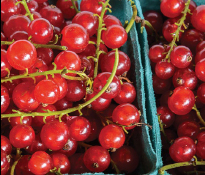 “Many of the people we see here are passing through, on their way to something else that’s going on in the area,” Dutton says. Some of those goings-on, however, are popular celebrations of Vermont’s tasty berries. One of the most charming, most authentically small-town events in the state is the annual Strawberry Festival on the green in picturesque Middletown Springs on VT Route 133. It has been run as a fundraiser by the local historical society one afternoon each June for 40 years. “We have such a nice time,” says Pat Hemenway, the Historical Society’s treasurer. “On the green, we set up dining tables with fine tablecloths, and beautiful bouquets of flowers from our gardens. There is lovely music, such as acoustic guitar. There are works by local artists and crafts on display, and usually a doll raffle.” Checking her accounts, she notes that last year, the volunteers hulled and sliced about 176 pounds of Vermont-grown strawberries; they went through 20 quarts of real whipped cream from a Vermont family-owned dairy, plus several gallons of Stewart’s vanilla ice cream. The menu at the festival is timeless in its simplicity. Hemenway says, “We offer old-fashioned strawberry shortcake, that is, the kind with freshly baked country-style biscuits, and it comes with lemonade, iced tea or coffee.”
“Many of the people we see here are passing through, on their way to something else that’s going on in the area,” Dutton says. Some of those goings-on, however, are popular celebrations of Vermont’s tasty berries. One of the most charming, most authentically small-town events in the state is the annual Strawberry Festival on the green in picturesque Middletown Springs on VT Route 133. It has been run as a fundraiser by the local historical society one afternoon each June for 40 years. “We have such a nice time,” says Pat Hemenway, the Historical Society’s treasurer. “On the green, we set up dining tables with fine tablecloths, and beautiful bouquets of flowers from our gardens. There is lovely music, such as acoustic guitar. There are works by local artists and crafts on display, and usually a doll raffle.” Checking her accounts, she notes that last year, the volunteers hulled and sliced about 176 pounds of Vermont-grown strawberries; they went through 20 quarts of real whipped cream from a Vermont family-owned dairy, plus several gallons of Stewart’s vanilla ice cream. The menu at the festival is timeless in its simplicity. Hemenway says, “We offer old-fashioned strawberry shortcake, that is, the kind with freshly baked country-style biscuits, and it comes with lemonade, iced tea or coffee.”
Growing up, I was one of those free-range country children who, along with my two brothers and our pals from the nearby farms, spent hours picking low-bush blueberries out in the cow pastures, not thinking that we might be stampeded any minute. Wild raspberries and blackberries, it seemed to me, only grew in the wildest places, a tangle of puckerbrush at the edges of old logging roads and clearings far back in the woods. We were awol for hours at a time. And strawberries–those we simply pilfered, along with a little rhubarb, from the meticulously tended garden of the older couple down the road whenever they weren’t home.
Now, I just check my email for the latest PYO alerts and head over to any number of masterfully cultivated farms and orchards to gather the most delicious fruits of the season.
It’s almost too easy. ◊
Anita Rafael lives and works in Wardsboro, Vermont. She has been a frequent contributor to Stratton Magazine since 2007.
